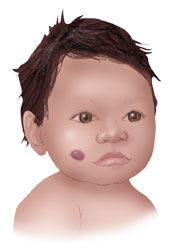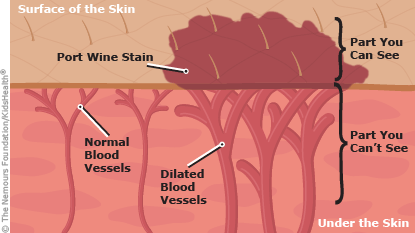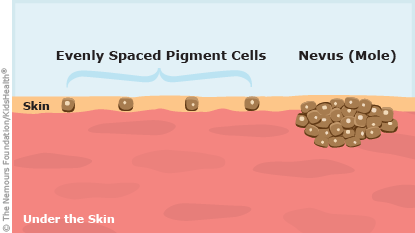Birthmarks
Newborns often have temporary pimples or blotches that soon disappear as they adapt to life outside the womb. It’s also quite common to see birthmarks on their skin at birth or shortly after. Birthmarks range from hardly noticeable to disfiguring, but no matter how large or small they are, they can be upsetting.
Birthmarks can be flat or raised, have regular or irregular borders, and have different shades of coloring from brown, tan, black, or pale blue to pink, red, or purple. The two main types of birthmarks are red, vascular birthmarks (for example, “strawberry”hemangiomas, port-wine stains, and “stork bites”) and pigmented birthmarks (such as moles, café-au-lait spots, and Mongolian spots).
 They’re mostly harmless and many even go away on their own or shrink over time. Sometimes birthmarks are associated with other health problems, though, so talk to your doctor about whether this might be the case for your child.
They’re mostly harmless and many even go away on their own or shrink over time. Sometimes birthmarks are associated with other health problems, though, so talk to your doctor about whether this might be the case for your child.
What Causes Birthmarks
Birthmarks can’t be prevented and they’re not caused by anything done or not done during pregnancy. There’s no truth to old wives’ tales about “stains” being caused by something the mother did or ate. The cause of most birthmarks is unknown. They can be inherited, but usually are not, and typically are unrelated to trauma to the skin during childbirth.
Types of Birthmarks
两种主要类型的胎记物由它们的原因差异化。血管(血管)胎儿发生当血管不正确时发生 - 无论是太多,还是它们都比往常更宽。着色的胎记是由细胞的过度生长引起的皮肤中的色细胞引起的。
Vascular Birthmarks
The most common vascular birthmarks are macular stains, hemangiomas, and port-wine stains:
Macular stains.也称为鲑鱼补丁,天使吻或鹳叮咬,这些微弱的红色标记是最常见的血管胎记类型。它们经常在额头或眼睑上,颈部背部,或鼻子,上唇或头部的鼻子。当宝宝哭泣时,它们可能更加明显。最常常他们在孩子1到2岁的时候自己逐渐消失,虽然有些人进入成年期。
Hemangiomas.Hemangiomas are classified as superficial when they appear on the surface of the skin (“strawberry marks”) and deep when found deeper below the skin’s surface. They can be slightly raised and bright red and sometimes aren’t visible until a few days or weeks after a baby is born. Deep hemangiomas may be bluish because they involve blood vessels in deeper layers of the skin.
Hemangiomas grow rapidly during the first 6 months or so of life, but usually shrink back and disappear by the time a child is 5 to 9 years old. Some, particularly larger ones, may leave a scar as they regress that can be corrected by minor plastic surgery. Most are on the head or neck, although they can be anywhere on the body, and can cause complications if their location interferes with sight, feeding, breathing, or other body functions.
Port-wine stains.These are discolorations that look like wine was spilled on an area of the body, most often on the face, neck, arms, or legs. Port-wine stains can be any size, but grow only as the child grows. They tend to darken over time and can thicken and feel like pebbles in midlife adulthood unless treated. They never go away on their own. Ones near the eye must be assessed for possible complications involving the eye.

Pigmented Birthmarks
The most common pigmented birthmarks are café-au-lait spots, Mongolian spots, and moles:
Café-au-lait spots.These very common spots are the color of coffee with milk, hence their name. They can be anywhere on the body and sometimes increase in number as a child gets older. One alone is not a problem. However, it’s wise to have your child evaluated if there are several spots equal to or larger than 0.5 cm (for a younger child) or equal to or larger than 1.5 cm (for an older child), which can be a sign of neurofibromatosis (a genetic disorder that causes abnormal cell growth of nerve tissues).
蒙古斑点。These flat, bluish-gray patches are often found on the lower back or buttocks. They are most common on darker skin, such as on children of Asian, American Indian, African, Hispanic, and Southern European descent. They usually fade — often completely — by school age without treatment.

Moles (congenital nevi, hairy nevus).Mole is a general term for brown nevi (one is called a “nevus”). Most people get moles at some point in life. One present at birth is called a congenital nevus and will last a lifetime. Large or giant congenital nevi are more likely to develop into skin cancer (melanoma) later in life, although risk is low in both. Smaller congenital nevi may have a slight increase in risk. Moles can be tan, brown, or black; flat or raised; and may have hair growing out of them.

When to Call the Doctor
A doctor should evaluate a birthmark when it first appears to determine its type and what kind of monitoring and treatment it needs, if any. Call the doctor if a birthmark ever bleeds, hurts, itches, or becomes infected. Like any injury where there is bleeding, you should clean the wound with soap and water and, using a gauze bandage, place firm pressure on the area until the bleeding stops. If the bleeding doesn’t stop, call the doctor.
Open sores sometimes form with hemangiomas and can get infected. Pigmented birthmarks rarely cause other problems, although moles should be checked throughout life for changes in size, color, or texture, which may be normal or could be a sign of skin cancer.
Treating Birthmarks
Pigmented birthmarks are usually left alone, with the exception of congenital moles and, occasionally, café-au-lait spots. Moles — particularly large or giant congenital nevi — sometimes are surgically removed, though larger ones may be more difficult to remove. Café-au-lait spots can be removed with lasers (highly concentrated light energy) but often return.
Vascular birthmarks, on the other hand, can be treated. The exception is macular stains, which usually fade away on their own; ones at the back of the neck may be more persistent but are not very noticeable.
Port-wine stains and certain hemangiomas can be disfiguring and embarrassing for children. Hemangiomas are usually left alone, as they typically shrink back into themselves by age 9. Larger or more serious hemangiomas often are treated with medication.
Lasers are the treatment of choice for port-wine stains. Most lighten significantly after several treatments with a “pulsed-dye” laser, although some return and need re-treatment. Laser treatment is often started in infancy when the stain and the blood vessels are smaller. Marks on the head and neck are the most responsive to laser treatment. Special opaque makeup also can camouflage a port-wine stain.
Helping Kids Deal With Birthmarks
It can be a shock at first to see a birthmark on your newborn. Nobody is perfect, yet many people have an image of a perfect baby in their heads. If the birthmark is clearly visible, people might ask questions or stare, which can feel rude. It helps to have a simple explanation ready to handle intrusions like this. Most people mean no harm, but it’s also OK to let them know if they’ve gone too far.
甚至在年轻的时候,孩子们观察他们的父母respond to situations like this. This is where they lean how to cope with others’ reactions. Talking simply and openly about a birthmark with kids makes them more likely to accept one as just another part of themselves, like hair color. And practice simple answers they can use when asked about it: “It’s just a birthmark. I was born with it.” It’s also important emotionally for kids to be around supportive family and friends who treat them normally.
Reviewed by:Patrice Hyde, MD
Date reviewed: April 2013

